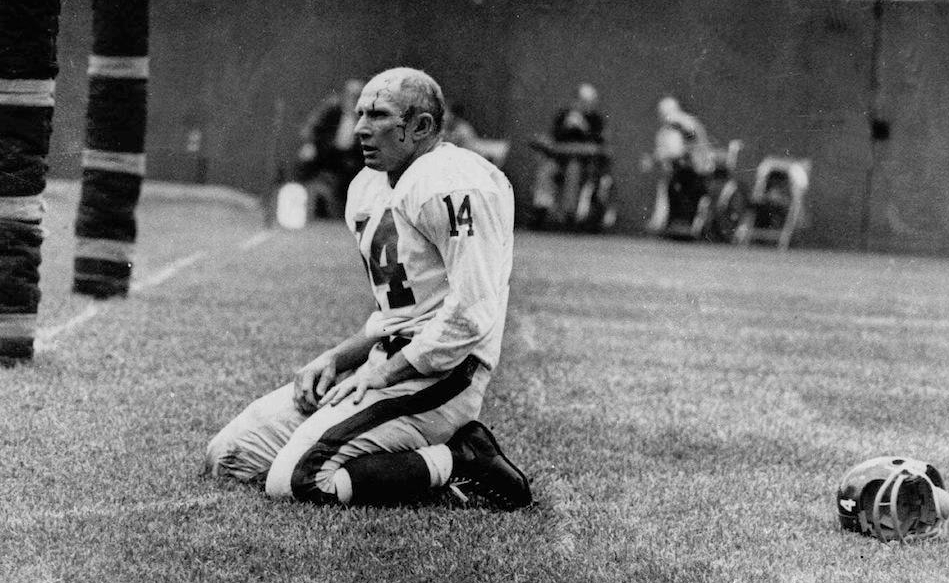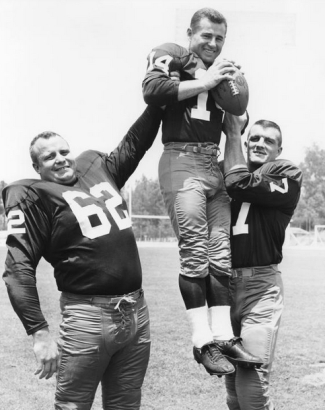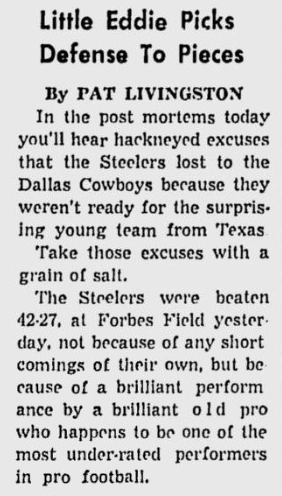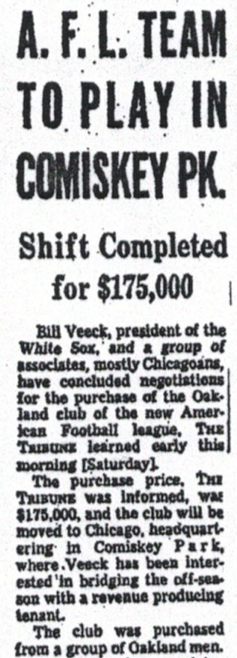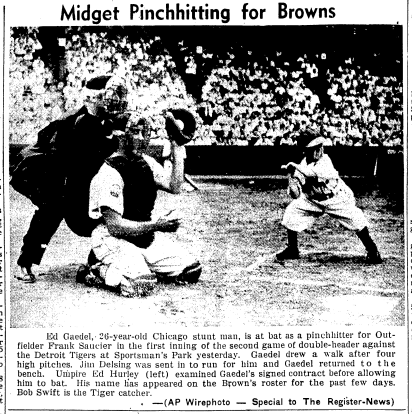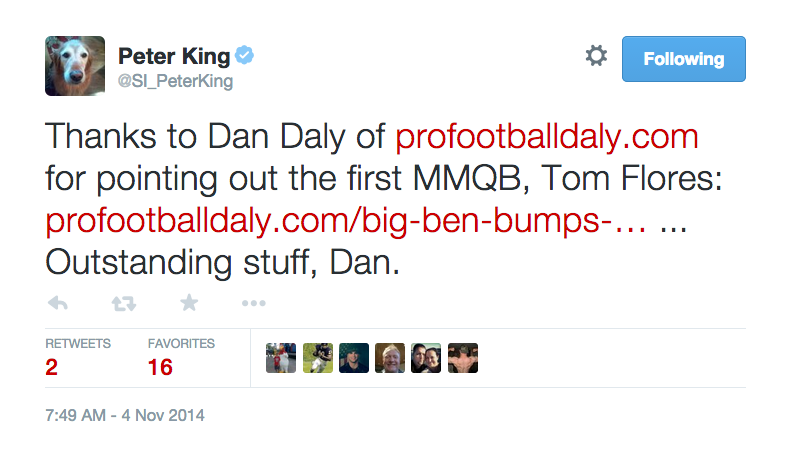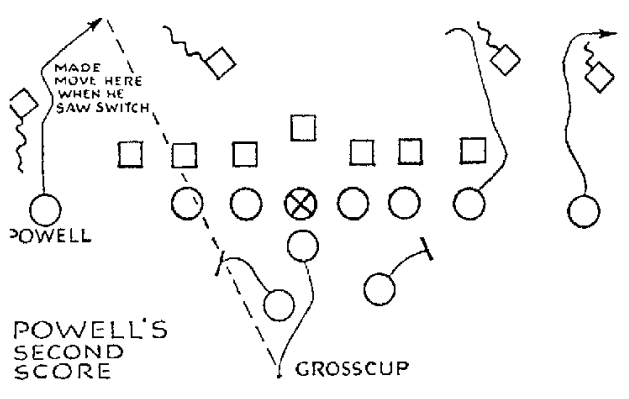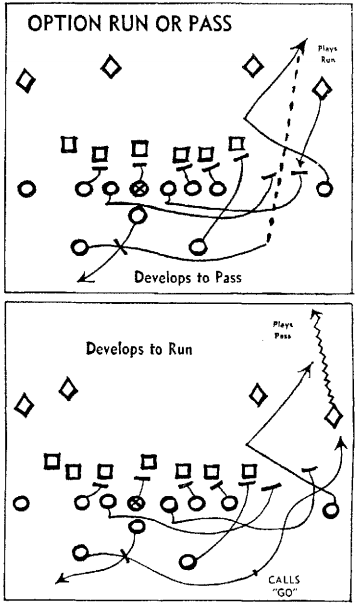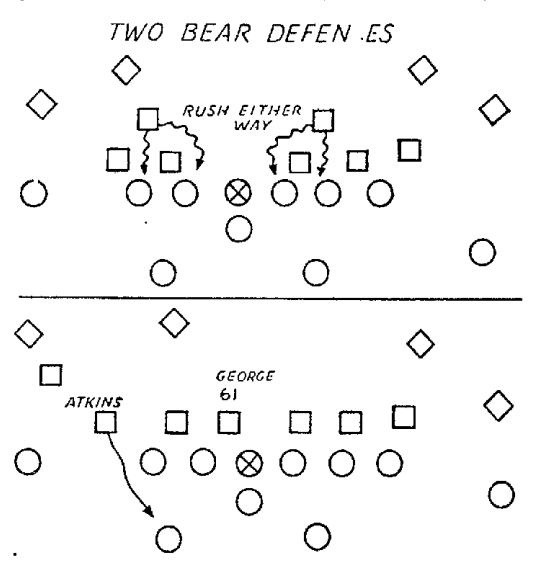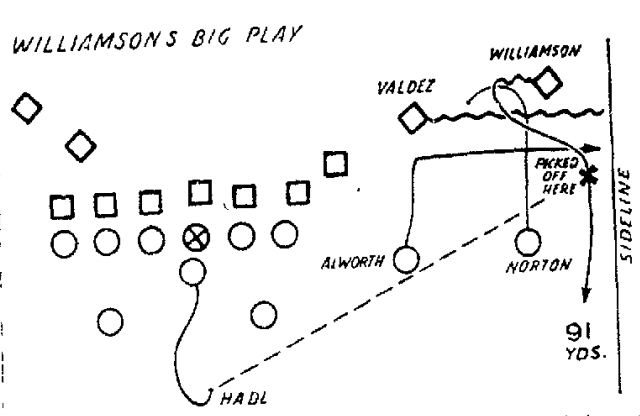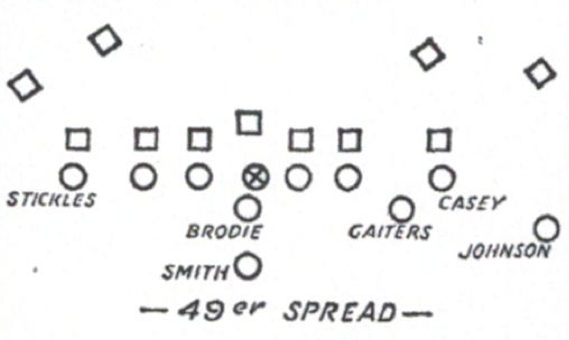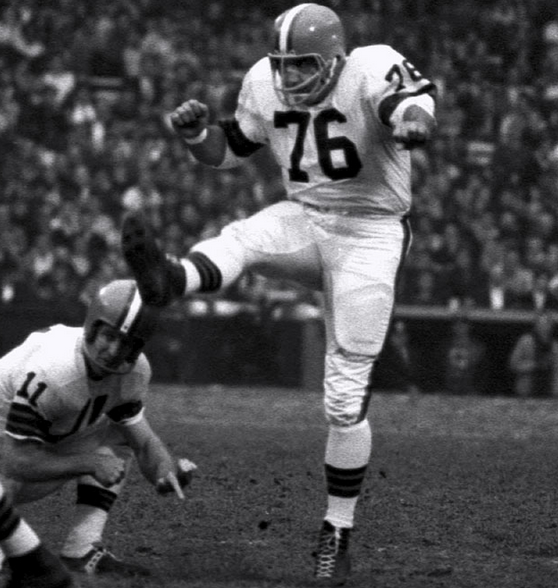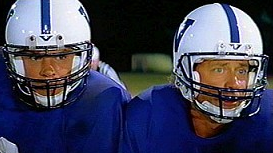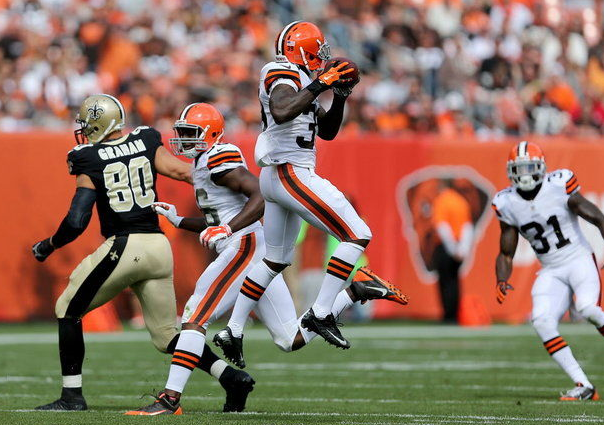Good thing Peyton Manning snapped out of it after throwing two early interceptions against the Raiders, otherwise the overreactive media would have started to paint pictures like this:
Monthly Archives: November 2014
Seven weeks before the Sudden Death Game
The Cowboys played the Jaguars in London today, but the NFL wasn’t always this big.
Consider: On this day in 1958, the Colts lost to the Giants at Yankee Stadium, 24-21 – a preview of their overtime thriller later that year in the title game. Afterward, their Hall of Fame receiver, Raymond Berry, went to CBS’s studios in New York and had a panel of celebrities try to guess his occupation on the game show What’s My Line?
Except for a pair of glasses — which were no disguise (he needed them) — Berry did nothing to hide his identity. He even signed in, with wonderful penmanship, as “Raymond Berry” — instead of, say, R. Emmett Berry or R. E. Berry, which would have been trickier.
But again, this was 1958. So even though Berry had led the NFL in receiving yards the year before — and would lead it in receptions and receiving touchdowns in that ’58 season — he wasn’t immediately recognized. The panelists were very observant, though, noticed his athletic physique and ramrod-straight posture, and quickly figured him for a jock.
The exchange between Bennett Cerf, the publisher/humorist, and Berry was just priceless:
Cerf: You’re playing at the present time on some professional outfit. Is that correct?
Berry: Yes, sir.
Cerf: Is it a football team?
Berry: Yes, sir.
Cerf: Is it a football team in the National Football League?
Berry: Yes, sir.
Cerf:: Did you play today in that fantastically exciting game up at the Yankee Stadium?
Berry: Yes, I did.
Cerf: Well, then, you’re a football player on either the Colts or the Giants. . . . Uh, Berry, . . . Raymond Berry. . . . You’re the end who almost caught a pass in the last quarter that would have beaten the Giants. You’re an end for the Baltimore Colts.
Berry: That’s right, sir.
Here’s the whole clip:
Did you notice, by the way, how Cerf pronounced Johnny Unitas’ last name as “YOU-knee-toss”? (Unitas had missed the game with broken ribs, and backup George Shaw had thrown three TD passes, including a 23-yarder to Berry.) Yes, it was a different world in 1958 — before London games and the NFL Network. But you have to remember: In those days, the Colts-Giants game would have been blacked out in New York. The only way Cerf or anybody on the panel could have seen it is if they had a ticket — unless, that is, they wanted to drive to Connecticut, outside the Blackout Zone, and rent a hotel room.
Anyway, on Dec. 28, Raymond Berry returned to New York and caught 12 passes for 178 yards and a touchdown as the Colts defeated the Giants, 23-17, in OT. Had he gone on “What’s My Line?” that night, Cerf probably wouldn’t have said to him, “You’re playing at the present time on some professional outfit. Is that correct?”
Ryan Fitzpatrick is no “Little General”
Came across an interesting passage in Bill Simmons’ longer-than-your-small-intestine column Friday for Grantland. Wrote Bill:
By the way, I think we should put a bow on Ryan Fitzpatrick’s career as a starting QB.
Record as a starter: 31-54-1
Number of NFL teams that started him: 5
Number of winning seasons: 0
Most wins in one season: 6
Career: 117 touchdown passes, 101 picks, 28 lost fumbles, 185 sacks, 78.4 ratingHere’s why I brought this up. . . . Has anyone started 85 NFL games and won less than Fitzpatrick? We know Joey Harrington finished 26-50 and David Carr finished 23-56 . . . but did anyone win a lower percentage of 85 or more games than Fitzpatrick’s minus-23?
Fortunately, Grantland has one of the best editorial assistants/competitive eaters in the world: the one and only Danny Chau. Here’s what Danny found out: Only one player in football since 1920 has won less than Fitzpatrick after starting at least 85 games, a 5-foot-9 quarterback named Eddie “The Little General” LeBaron, who had a 26-52-3 record from 1952 to 1963.
Actually, if you study the information provided by The Competitive Eater (courtesy of pro-football-reference.com), you’ll see this isn’t true. Two other quarterbacks besides LeBaron started “at least 85 games” and had “a lower winning percentage” than Fitzpatrick — and two more had percentages that were nearly as bad. The list should read like this:
[table]
Years,Quarterback,Teams,W,L,T,Pct
1971-84,Archie Manning,Saints\, Oilers\, Vikings,35,101,3,.263
1952-63,Eddie LeBaron,Redskins\, Cowboys,26,52,3,.340
1961-76,Norm Snead,Redskins\, Eagles\, Vikings\, Giants\, 49ers,52,99,7,.351
2005-14,Ryan Fitzpatrick,Rams\, Bengals\, Bills\, Titans\, Texans,31,54,1,.366
1987-99,Chris Miller,Falcons\, Rams\, Broncos,34,58,0,.370
1990-2001,Jeff George,Colts\, Falcons\, Raiders\, Vikings\, Redskins,46,78,0,.371
[/table]
Note: The data lists LeBaron as having 85 starts but credits him with only 81 decisions.
Another way of looking at it, of course, is:
George (1990) was the first pick in the draft.
Manning (1971) and Snead (1961) were the second.
Miller (1987) was the 13th.
And LeBaron (123rd, 1950) and Fitzpatrick (250th, 2005), the two outliers, have the least explaining to do.
And another way of looking at it is to say: For goodness sakes, whatever happened to context? Eddie “The Little General” LeBaron and Ryan Fitzpatrick have almost nothing in common except
their position. LeBaron was one of the better quarterbacks of his era, a four-time Pro Bowler who was a magician as a ball-faker and even did some punting (averaging 40.9 yards on 171 kicks). He just had the misfortune of spending his first seven seasons with the Redskins (whose bigoted owner, George Preston Marshall, wouldn’t sign black players) and his last four with the expansion Cowboys.
Pro-football-reference.com lists LeBaron at 5-foot-9, but the Cowboys media guide in 1963, his final season, puts him at 5-7. When he retired, he was 13th in NFL/AFL history in both passing yards (13,399) and touchdown passes (104). Those totals may not seem like much today, but the ’50s and early ’60s were a much different time.
Some of LeBaron’s individual seasons were outstanding. In 1957 (86.1) and ’58 (83.3) he finished second to Colts Hall of Famer Johnny Unitas in passer rating. In ’62 he led the league (95.4). That was the year he might have played his most amazing game. In a 42-27 win over the Steelers in Pittsburgh, he threw for five touchdowns in a mere 15 attempts while rotating at QB with Don Meredith. Repeat: He threw for five TDs despite playing only about half the game. Here’s Pat Livingston writing about it in The Pittsburgh Press:
Can you imagine anybody calling Ryan Fitzpatrick “a brilliant old pro who happens to be one of the most underrated performers in pro football”? So again, a little context, please. Fitzpatrick and LeBaron in the same sentence? They’re not even in the same universe. Going into this season, Fitzpatrick had never had a year when his passer rating was higher than the league average.
Yup, The Little General could play. And Fitzpatrick, the Harvard grad, will appreciate this: While Eddie was with the Redskins, he got his law degree at George Washington and practiced law in Dallas — that is, when he wasn’t busy throwing five touchdown passes in half a game.
When Bill Veeck “bought” the Raiders
The Raiders’ talks with San Antonio officials are one of the great dog-bites-man stories of the season. This is the franchise, after all, that divorced Oakland in 1982, shacked up with Los Angeles for 13 years, Lost That Lovin’ Feeling and remarried Oakland. And now, of course, the Raiders want a nice, new stadium, just like the 49ers have, and are hoping for a Public Handout to accomplish this objective. The San Antonio flirtation is supposed to expedite things, but we’ll see how badly the city wants to keep this shipwreck of a football team.
Forgotten fact: In January 1961, after their very first season in the AFL, the Chicago Tribune reported that the Raiders had been sold to a group headed by White Sox owner Bill Veeck, who planned to have them play at Comiskey Park. The stadium had lost its football tenant when the Cardinals moved to St. Louis the year before, and Veeck and his partners were looking for another renter.
On Jan. 14, this headline topped the front page of the Chicago Tribune sports section:
Here’s the gist of the story:
The story made sense on many levels, not the least being that the Raiders had lost an estimated $270,000 in their inaugural season and had major stadium issues. They’d played their first four home games at Kezar Stadium, home of the NFL’s 49ers, and their last three at Candlestick Park, home of the baseball Giants.
A day later, everybody was denying everything. Raiders owner Wayne Valley said, “It’s the first I’ve heard of it, and it’s completely untrue. It’s a shot in the dark.” And Veeck said, “We would like to have a tenant for Comiskey Park in the offseason, but I wouldn’t go as far as buying Oakland to get one.”
The Oakland Tribune began its story thusly:
Making one of the quickest trips on record, the Oakland Raiders of the American Football League today moved to Chicago and within a couple of hours were back in Oakland.
How did the Chicago paper get it wrong? Well, the reporter either jumped the gun, had unreliable sources or . . . there was one other possible scenario, suggested by United Press International: When AFL owners, meeting in Houston, first heard the report, “a spokesman said they ‘appeared to be amused by it — especially its origin in Chicago on the same day the Chicago Bears lost one of their key players to the AFL,’” the wire service reported. (Translation: George Halas, or one of his operatives, planted the story to rile the rival league.)
The player was receiver Willard Dewveall, who had played out his option with the Bears and signed with the AFL’s Oilers. Dewveall wasn’t a superstar, but he’d totaled 804 receiving yards in 1960, seventh best in the league, and was the first recognizable NFL player to jump to the AFL.
It would have been fun to see what would have happened if Veeck had gotten hold of the franchise. This was the iconoclast, after all, who once sent a midget up to bat for the St. Louis Browns, the guy who gave us the exploding scoreboard. But the Raiders managed all right under Valley and Al Davis in Oakland, even if they have always had an eye out for greener pastures.
More from Tom Flores, the first MMQB
My post on Tom Flores’ stint as the Oakland Tribune’s Monday Morning Quarterback in 1962 got some nice attention. Sports Illustrated’s Monday Morning Quarterback, Peter King, tweeted out a link to it, and the result, naturally, was a flock of new visitors to the site.
So I thought I’d follow up with a bit more from the Flores/MMQB file — more X’s and O’s, in particular.
Let’s start with his Sept. 10 column, after the Raiders dropped their opener to the New York Titans, 28-17. Flores:
New York’s secret was no secret — just the long pass. They scored all their points from outside our 20 and all through the air. Powell, New York’s spread end, made his touchdowns on a sideline-and-up and on a post pattern.
From where I sat it looked like his post pattern was not called in the huddle, and he confirmed this to the writers later. As he was running some other pattern downfield, our deep backs switched off to what was supposed to be a zone or switch-off between safety man and corner man. But our backs got confused and Powell adjusted his pattern into a post, hoping that [quarterback Lee] Grosscup would have enough time to spot the change. Lee did . . . and hit Art with a beautiful throw which put New York out in front 28 to 10.
The accompanying diagram:
On Sept. 15, with the Raiders off that week, Flores weighed in on the 49ers. One thing he touched on was the halfback option play:
Now that Bill Kilmer has been moved to running back [from quarterback], a new weapon will be introduced: the run-or-pass option. This play, with the right person running it, can be one of the most dangerous in football. [Frank] Gifford of the Giants and [Paul] Hornung of the Packers are perfectionists of this play.
It starts out like an end sweep, except the flanker, instead of blocking, fakes in as if he were going to block and then runs a corner pattern. The halfback runs it like he would any normal end sweep, only he has his eye on his flanker and the deep defensive back on that sideline. If the defensive back reads “run” and shoots up . . ., the halfback slows up and throws a nice soft pass so the flanker can run under it as he cuts to the corner.
Should the deep back read “pass” and stay with the flanker, all the halfback has to do is yell “go” and his guards will turn upfield as they would on an end sweep.
Two days later, following the Niners’ 30-14 loss to the Bears, Flores wrote about Chicago’s pass rush, which registered seven sacks for 64 yards and was essentially the story of the game:
[The Bears] had linebackers running in and out of spots in the line all day long, and most of the time they ended their assignments in [QB] John Brodie’s lap. Bill George, the great middle linebacker, and Joe Fortunato, outside linebacker, kept the 49er[s] offense confused. From a regular pro-type defense with four big men up on the line of scrimmage, they would jitterbug back and forth from various spots along the line and on the snap of the ball go shooting through on either side of the defensive tackles or ends. . . . On 90 percent, or so it seemed, of their defensive plays they shot at least one backer but more often two or three.
They used several types of defensive setups. One in particular seemed to really give the 49ers a rough time. On this defense George would get into the line in a regular lineman’s stance, and the rest of the linemen on the split end side would move out a couple of feet.
This left giant end Doug Atkins (6-8) outside the offensive tackle, and man did he come hard. He and Brodie got to know each other pretty well on a not-so-friendly basis.
On Oct. 1, Flores analyzed a 91-yard pick-six by cornerback Fred Williamson that had given the Raiders a 14-7 lead over the Chargers (in a game they ultimately lost, 42-33):
Fred actually intercepted a pass thrown for another man’s receiver. It went like this. San Diego lined up in a slot-right formation with [Don] Norton spread far out and [Lance] Alworth flanked inside, between Norton and the tackle. As the ball was centered, the outside man, Norton, ran up the field and curled in toward the middle, ending up in a deep hook pattern, at about 15 yards. Williamson went with him and had him covered.
The flanker, meanwhile, ran downfield and cut toward the sideline behind Norton at about 10 yards. This was [safety Vern] Valdez’s man, and he was right behind him ready to go for the ball. On the release of the ball, Fred left his man and went for the interception, cutting in front of Alworth. Somehow, Fred made a leaping catch that almost sent him to the turf, maintained his balance while he struggled to stay inbounds and then turned on his fine speed and outran the remaining Chargers who were coming over to lend a helping hand.
I could go on, but I’ll wrap it up with Flores’ Dec. 10 column. The 49ers had played Vince Lombardi’s Packers tough in a 31-21 defeat — they were up 21-10 at the half — and Tom was impressed with an offensive wrinkle they came up with for Green Bay, one that enabled Brodie to complete 13 of 15 passes in the first half (against a defense, I’ll just remind you, with five Hall of Famers):
The Niners came out with a new type of spread formation that gave the Packers fits the entire first half. With both ends tight, the flanker would spread to either side. On that side the tight end would spread out just about five yards and the halfback would slot in between the end and the tackle. This left only the fullback in the backfield in his regular position behind the quarterback.
From this formation the 49ers did several things. They would send the fullback in motion away from the strength, quick-toss to the fullback to the strength, fake a reverse to the halfback and throw a pass or give to the halfback on the reverse.
Clearly, Flores’ talents went beyond quarterbacking and coaching. His analysis in his Monday Morning Quarterback column was far ahead of its time — good enough to pass muster today. Even the Tribune’s diagrams, though primitive, painted a decent picture of pro football in the early ’60s.
Friday Night Fights IX: Tom Zbikowski vs. Blake Warner, 2011
What would our Friday Night Fights series be without a Tom Zbikowski bout?
Zbikowski, the future Ravens safety/special teamer, was still in college — a junior at Notre Dame — when he made his professional debut in June 2006 by knocking out Robert Bell in 49 seconds.
It was a semi-big deal. Bob Arum was the promoter, Angelo Dundee worked Tommy Z’s corner and the setting was Madison Square Garden.
According to NCAA rules, Zbikowski, a cruiserweight, could accept his $25,000 purse and still retain his football eligibility, but he couldn’t “accept any money from any manufacturer to wear a specific brand of boxing apparel,” The New York Times reported.
By that time he’d had 90 amateur fights, compiling a 75-15 record. “I think I avenged all those losses,” he once told the Los Angeles Times, “and I probably had 10 to 20 more fights not listed, in smokers and stuff around the [Chicago] area.”
The Ravens drafted Zbikowski in the third round in 2008, and he spent four years in Baltimore backing up strong safety Ed Reed, returning kicks and running down under them. After that came a season with the Colts that was ended, five games early, by a shin injury.
Tommy Z was a Wild Child, as you might expect of a boxer-footballer. “I’m the only guy who can drink six beers, then spar 10 rounds on the same day,” he bragged to the Chicago Tribune’s David Haugh last November. Wrote Haugh:
Alcohol had become such a part of Zbikowski’s routine the night before games that he compared it to a superstition. His ideal mix: four glasses of scotch and four Guinnesses. Of the 64 NFL games Zbikowski participated in, he estimated at least 12 were played with a massive hangover.
“Get a little messed up, sneak a girl into your room, feel on top of the world,” Zbikowski said. “I had some of my best games off of benders — some of my worst, too. My two best seasons ever were 2005 [at Notre Dame] and 2009 [in Baltimore], when I was the most out of control drinking, so I thought, hey, maybe I should go back to that.’”
But for the first time in Indy, Zbikowski felt his nighttime activities affecting his game-day ability.
“I was drinking too much,” Zbikowski said. “I got fat.”
To lose the weight, he said, he took a diuretic, a blunder — the substance was banned by the NFL — that earned him a four-game suspension at the start of the 2013 season. It turned out to be moot, though, because he didn’t make it out of training camp. His hometown Bears, who had signed him in the offseason, released him, and that was the end of his football career.
But back to boxing. In March and April of 2011, when NFL players were locked out by the owners, Zbikowski climbed in the ring three more times — the last three of his four professional bouts. He TKO’d Richard Bryant in one round, won a unanimous four-round decision over Caleb Grummet, then had the following fight against Blake Warner, who, as you’ll see, had the body of a middle-school assistant principal.
All told, Tommy Z spent less than 17 minutes in the ring as a pro — 16 minutes, 54 seconds, to be exact. How good was he? Arum thought he had prospects, though Bob was probably thinking mostly about all the Notre Dame subway alumni who might come to his bouts. We’ll give Emanuel Stewart, who trained Zbikowski at the end, the final word on the subject. After Tommy hung on in the fourth round to beat Grummet, a mixed-martial-arts guy, Stewart said, “Thank goodness it wasn’t a six-round fight.”
One more thing: This clip has Spanish broadcasters — a Friday Night Fights (and Pro Football Daly) first. Don’t worry, though. “Zbikowski” in Spanish is still “Zbikowski.”
The NFL’s last scoreless tie?
The record book says the last scoreless tie in the NFL was played Nov. 7, 1943 — 71 years ago today — when the Giants and Lions battled pointlessly in the rain and mud of Briggs Stadium. But I say it happened about two decades later, when the Giants’ Frank Gifford and the Eagles’ Timmy Brown competed against each another on “Password,” the popular TV game show, and posted zeroes in the second round:
You’ve gotta admit, that segment was every bit as exciting as, well, a 0-0 deadlock. By the way, how beautiful is it that Brown’s partner was Betty White? No one would have believed in the ’60s that fair Betty would go on to do a Snickers commercial in which she got flattened trying to catch a pass in a touch football game — a game played in conditions, you’ll notice, much like the “last” scoreless tie between the Giants and Lions in 1943.
If only Abe Vigoda had been teamed with Gifford on “Password.”
From one Hall of Famer to another
Would it surprise you to learn that not one of Dan Marino’s 420 touchdown passes — he held the career record for a while, you may recall — was caught by a fellow Hall of Famer? (Guess I never thought about it, but yeah, I wouldn’t have imagined.) What’s more, Marino isn’t the only QB in Canton who can say that. Today’s entertainment:
Fewest TD Passes by a Hall of Fame QB to Another Hall of Famer (Modern Era)
0 Dan Marino, Dolphins, 1983-99 — Career total: 420.* Hall of Fame receivers: none.
0 Len Dawson, Steelers/Browns/Texans/Chiefs, 1957-75 — Career total: 239. Hall of Fame receivers: none.
3 Fran Tarkenton, Vikings/Giants, 1961-78 — Career total: 342.* Receiver: Hugh McElhenny, Vikings, 3.
6 George Blanda, Bears/Colts/Oilers/Raiders, 1949-58, ’60-75 — Career total: 236. Receiver: Fred Biletnikoff, Raiders, 6.
7 Sid Luckman, Bears, 1939-50 — Career total: 137. Receiver: George McAfee, 7.
9 Sammy Baugh, Redskins, 1937-52 — Career total: 187.* Receivers: Wayne Millner, 7; Cliff Battles, 1; Bill Dudley, 1.
Compare that to this list:
Most TD Passes by a Hall of Fame QB to Another Hall of Famer (Modern Era)
139 Johnny Unitas, Colts/Chargers, 1956-73 — Career total: 290.* Receivers: Raymond Berry, Colts, 63; Lenny Moore, Colts, 43; John Mackey, Colts, 32; Joe Perry, Colts, 1.
112 Sonny Jurgensen, Eagles/Redskins, 1957-75 — Career total: 255. Receivers: Charley Taylor, Redskins, 53; Tommy McDonald, Eagles, 30; Bobby Mitchell, Redskins, 29.
106 Jim Kelly, Bills, 1986-96 — Career total: 237. Receivers: Andre Reed, 65; Thurman Thomas, 22; James Lofton, 19.
98 Terry Bradshaw, Steelers, 1970-83 – Career total: 212. Receivers: Lynn Swann, 49; John Stallworth, 44; Franco Harris, 5.
85 Steve Young, Bucs/49ers, 1985-99 — Career total: 232. Receiver: Jerry Rice, 49ers, 85.
84 Norm Van Brocklin, Rams/Eagles, 1949-60 — Career total: 173. Receivers: Crazylegs Hirsch, Rams, 32; Tommy McDonald, Eagles, 29; Tom Fears, 22, Rams; Andy Robustelli, Rams, 1.
75 Dan Fouts, Chargers, 1973-87 — Career total: 254. Receivers: Kellen Winslow, 41; Charlie Joiner, 34.
65 Otto Graham, Browns, 1946-55 — Career total: 174 (All-America Conference included). Receivers: Dante Lavelli, 57; Marion Motley, 7; Lou Groza, 1.
*Former record holder.
Amazing, isn’t it? Van Brocklin (48.6 percent), Unitas (47.9), Bradshaw (46.2), Kelly (44.7) and Jurgensen (43.9) threw almost half their touchdown passes to Hall of Famers. Now those must have been good times.
The two receivers who grab your attention are Robustelli and Groza. After all, Andy was a defensive end and Lou an offensive tackle/kicker. What were they doing grabbing TD passes?
Naturally, I had to find out the stories behind the stories. What I learned:
Robustelli’s score came in the Rams’ 1954 finale against the Packers. (That’s when teams often pulled stunts like this, in meaningless end-of-the-season games.) The Associated Press described the play thusly:
A surprise pass by Norm Van Brocklin was the key play of the game. The Rams were ahead 21-20 in the third period when Van Brocklin was faced with a fourth down and 25 yards to go. He dropped back – supposedly to punt. Instead he dropped a short pass to defensive end Andy Robustelli, who presumably was in the game to run down under the punt. The 220-pound Robustelli rolled most of the 49 yards for the touchdown.
● A 49-yard touchdown pass to a defensive end on fourth and 25. It doesn’t get much better than that, folks. Green Bay never seriously challenged again. Final score: Rams 35, Packers 27. Here’s the headline that ran in The Milwaukee Journal the next day:
● As for Groza’s touchdown, it was semi-historic. How so, you ask? Well, first of all, he scored on a tackle-eligible play, which was still legal in 1950. Second, near as I can determine, it’s the last such play to go for a TD in the NFL (mostly because it took place, like Robustelli’s score, on the last Sunday of the season).
The next year this neat bit of chicanery was outlawed, and the rule book was amended to read: “A center, guard or tackle is not eligible to touch forward pass from scrimmage even when on end of line” (as was the case with Groza, who, being uncovered on the left side, became an eligible receiver).
Harold Sauerbrei’s recounting of Lou’s heroics in the Cleveland Plain Dealer:
“With the ball on the 23, Groza broke away from his [line] post and Graham laid a soft pass between two defenders into Groza’s arms, Lou running 13 yards for the score.”
The fourth-quarter touchdown increased the Browns’ lead over the Redskins to 17, and they went on to a 45-21 victory. Two weeks later, they won their first NFL title.
If you’re wondering how some current quarterbacks might fit into this, Peyton Manning threw 112 TD passes when he was with the Colts to Marvin Harrison and four to Marshall Faulk. Assuming Harrison makes it to Canton, that’s 116 right there, which would put Manning second behind Unitas. But he could add to that number and possibly pass Johnny U. if any of his Broncos receivers — Wes Welker (11), Demaryius Thomas (30) or Julius Thomas (22) — gets voted in. (The same goes for Edgerrin James, who caught 11 scoring passes from him in Indianapolis.)
The Patriots’ Tom Brady also could overtake Unitas. At the moment, his ledger reads: 39 touchdown passes to Randy Moss, 34 to Welker and 49 (and counting) to Rob Gronkowski. Total: 122 (again, if all three wind up in the Hall, which is hardly guaranteed). But the way Gronk is going, Brady could push that figure quite a bit higher.
Source: pro-football-reference.com
Fraternal twins
Don’t ask me why — it’s a personal weakness, I’m sure — but whenever I think of the Broncos’ Two-Headed Thomas Monster, Demaryius and Julius, I think of Bob and Walt Tenor (Matt Damon and Greg Kinnear) in Stuck on You.
Tashaun Gipson’s six picks
How often are interceptions — the defensive kind — a topic of discussion in the NFL? Oh, every once in a while a DB will go wild, pick off three or four passes in a game, and you’ll think: How’d that happen? Did the Hot Tub Time Machine transport DeAngelo Hall back to 1962? Anything less than that, though, and . . .
So allow me to point out that, eight games into the season, Browns free safety Tashaun Gipson has six INTs. And while you’re stifling a yawn, let me also point out that six is halfway to 12, and nobody has had that many since Lester Hayes had 13 for the Super Bowl-winning Raiders in 1980. In fact, since ’81, when Everson Walls had 11 as an undrafted Cowboys rookie, nobody has had more than 10.
Here are the seven sneak thieves who’ve reached that total in the last two decades:
DBS WITH THE MOST INTERCEPTIONS IN A SEASON (LAST 20 YEARS)
[table width=”400px”]
Year,Defensive back\, Team,Int,Yds,TD
2007,Antonio Cromartie\, Chargers,10,144,1
2006,Champ Bailey\, Broncos,10,162,1
2006,Asante Samuel\, Patriots,10,120,0
2005,Ty Law\, Jets,10,195,1
2005,Deltha O’Neal\, Bengals,10,103,0
2001,Ronde Barber\, Bucs,10, 86,1
2001,Anthony Henry\, Browns,10,177,1
[/table]
For those of you scoring at home, there are 31 Pro Bowls in that group – Bailey 12, Law and Barber 5, Samuel 4, Cromartie 3 and O’Neal 2. Three of them, moreover, had more than 50 career picks (Law 53, Bailey 52, Samuel 51) and another had 47 (Barber). That puts them in the Top 20 since 1978, the year the league started legislating against defense. So if Gipson reaches double digits, he’ll be in good company.
Hey, just trying to work up some enthusiasm for The Other Side of the Ball. It ain’t easy these days. After all, Night Train Lane’s record of 14 interceptions in a season has stood since 1952, when they played only 12 games, and hasn’t been seriously challenged in ages. Look at it this way: Tom Brady and Ben Roethlisberger have thrown a combined six picks this year. That’s how many Gipson has. Impressed yet?
Source: pro-football-reference.com

